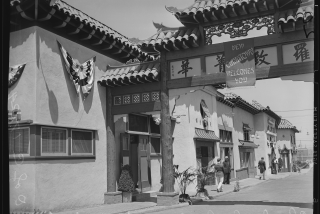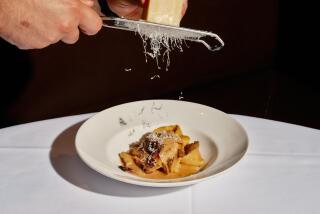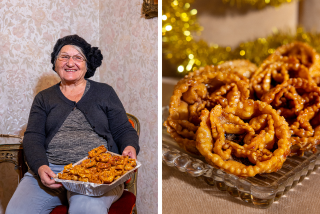NYC’s Little Italy Lacks 1 Ingredient: Italians
NEW YORK — After 40 years, Lunella Russo has seen it all on Mulberry Street: Boisterous festivals, like this weekend’s Feast of San Gennaro, which is expected to draw more than 2.5 million people. Booming real estate values, which have turned Little Italy into one of the city’s hottest neighborhoods. Blood-curdling mob violence, both real and cinematic.
But as the longtime restaurant owner scans the crowd for prospective customers this year, she sounds a melancholy note: “Once this place was home to so many Italians, and you knew it was a real Italian neighborhood. But no more. Little Italy is not at all what it was.”
Nowadays, most of the people who live in the historic community just north of Canal Street are Asian and Latino. The cramped tenement apartments that line the streets and were made famous in scenes from “The Godfather” are home to a dwindling number of aging Italian Americans.
There’s increasingly little that’s truly Italian in New York’s Little Italy, and the same is true for once-thriving ethnic enclaves in Boston, Philadelphia, Chicago, New Orleans, San Francisco and Newark, N.J. As young Italian Americans moved to new homes in the suburbs, the old neighborhoods shrank and, like Mulberry Street, became ethnic theme parks.
Some bemoan this trend, yet the differences between then and now may be academic to many of those pouring into Mulberry Street for this year’s 75th annual Feast of San Gennaro, the nation’s largest Italian street fair.
Visitors from throughout the New York metropolitan area and other states have been feasting on platters of calamari and scungilli, testing their skills at carnival games, paying respects at local churches, shopping for pottery bargains in bric-a-brac shops and trying on “The Sopranos” T-shirts. It’s a noisy 11-day party and the religious event that inspired it--the martyrdom of St. Gennaro, Naples’ patron saint, in 305--seems light-years away.
“We come down here every year and have a ball,” said Frank Marinello, wolfing down a sausage and pepper sandwich and eyeing the plate of sugarcoated zeppole in his wife’s hands. Marinello’s family moved out of Little Italy years ago, scattering to Long Island, New Jersey, Pennsylvania and Connecticut. “This festival,” he said, “is all about having fun.”
For others, it’s an attempt to reconnect with fraying traditions. This weekend, Los Angeles will enjoy what sponsors are calling the city’s first San Gennaro festival, a two-day event at Hollywood and Vine. Across the nation, there are similar celebrations, or festas, underway.
But for all the pageantry they offer, these festivals seem to have little or no connection with the daily lives of many Italian Americans, according to academic experts. Years after most of those of Italian descent moved out, Mulberry Street and its environs are best known for candlelight religious processions, cannoli-eating contests and Frank Sinatra wannabes crooning in cafes.
The legacy of organized crime also is a lure, but even that is changing. Although thousands of tourists still flock to Umberto’s Clam House, the site of a bloody gangland killing in 1972, the original is long gone and the current restaurant stands next to a Chinese laundry. John Gotti’s Ravenite Social Club, the Gambino family’s famed hangout, has become a hair salon.
“What you see in New York and other Italian American neighborhoods is the transformation of a once real place into a museum, a monument to an ethnic group,” said Jerome Krase, a sociology professor at Brooklyn College who has studied the fate of Little Italys across the country. “And these places offer a stereotypical view of what Italians are like. It’s like playacting on a grand scale, a reenactment of something that has vanished.”
New York’s Little Italy once was a hugely overcrowded tenement slum. Originally settled by German and Irish immigrants, the area was inundated with new arrivals from Southern Italy after U.S. immigration quotas were lifted in 1883. The often squalid neighborhood, where three and four families crammed into small apartments, was singled out for criticism by Jacob Riis in his trailblazing 1890 expose, “How the Other Half Lives.”
Gradually, however, Italian Americans found steady work building the city’s subways and bridges; others became police and firefighters. They prospered and re-created an old-world atmosphere on Mulberry, Mott, Grand and Elizabeth streets, filling them with restaurants, theaters, churches and clothing shops.
At one point, Little Italy boasted the largest Italian population of any urban center outside of Italy, once hitting an estimated 250,000. Yet the numbers began diminishing when Italian Americans--as did the German and Irish before them--grew weary of the neighborhood’s narrow streets and notoriously cramped living conditions.
In recent years, the area’s population has shrunk to about 5,000 people of Italian ancestry, while other ethnic groups have grown considerably, Krase said. Overall, however, this country’s Italian American population has grown to 15.9 million, according to the 2000 census.
“You’re raising a family, you got kids, so what are you gonna do?” said Russo, recalling her family’s eventual move to the suburbs. “You love a place like Mulberry Street, but you need room. And so one day you leave.”
As Italians left Little Italy, the population of nearby Chinatown began exploding. What began as a trickle of new stores became a torrent in 1968, when U.S. immigration restrictions were eased for Chinese immigrants. Suddenly, Italian shopkeepers were sharing sidewalks with Asian restaurants and vegetable stands. More important, Chinese businessmen began acquiring many of the older tenement buildings once owned by Italians.
“It’s like the whole place changed before your eyes,” said Johnny Cappello, a San Gennaro food vendor who was born on Mott Street but moved to a larger home in Brooklyn. “I feel so connected to this area. I can show you where my grandparents lived. But it’s such a different world now.”
As he spoke, tourists from all over the nation packed Mulberry Street, making it difficult to move. Later in the evening, a religious procession bearing the statue of San Gennaro slowly made its way past Cappello’s candy booth. To the clashing boom of a brass band and the cheers of thousands, visitors taped $1 bills to the statue as charity offerings.
Sponsors hope to raise several hundred thousand dollars this year, but until recently the festival was dogged by suspicions that it had become a cash cow for organized crime.
Former Mayor Rudolph W. Giuliani, emboldened by federal indictments of several organizers, successfully demanded in 1995 that an independent auditor examine the San Gennaro fund-raising operation.
The eye-popping report found that the festival was a mob-run enterprise that had raised $360,000 the previous year but had given $11,000 to charity. Since then, a new board of directors has been appointed.
“The feds drove the mob out,” said Jerry Capeci, a longtime organized crime expert and author of “The Complete Idiot’s Guide to the Mafia.”
“You can never completely obliterate the mob influence, because some gangsters still have hidden interests here. But it’s a huge change.”
On Mulberry Street, however, the biggest change of all may have nothing to do with crime-busting mayors or the steady expansion of Chinatown. As the procession bearing San Gennaro reached the end of the street, it passed upscale shoe boutiques, fitness clubs and chic restaurants. A Ralph Lauren store stood opposite a 19th century church. Up above, young professionals are moving into small one-bedroom apartments that rent for $3,000 a month or more.
“Soon, the whole place will be filled with outsiders, you watch,” Cappello said. “And, really, what do they know about Italian American life?”
It depends on your definition. Gina Malanga, a Rhode Island native, had a moment of ecstasy as night fell on Mulberry Street.
She couldn’t believe the sizzling aromas of sausage and onions, broccoli rabe, meatball hero sandwiches, steak and mozzarella, baked clams, lobster ravioli, calzone, veal parmigiana, grilled eggplant, tripe marinara, rice balls and stuffed artichokes.
“So many choices!” she said. “It’s like Disneyland.”
More to Read
Eat your way across L.A.
Get our weekly Tasting Notes newsletter for reviews, news and more.
You may occasionally receive promotional content from the Los Angeles Times.










